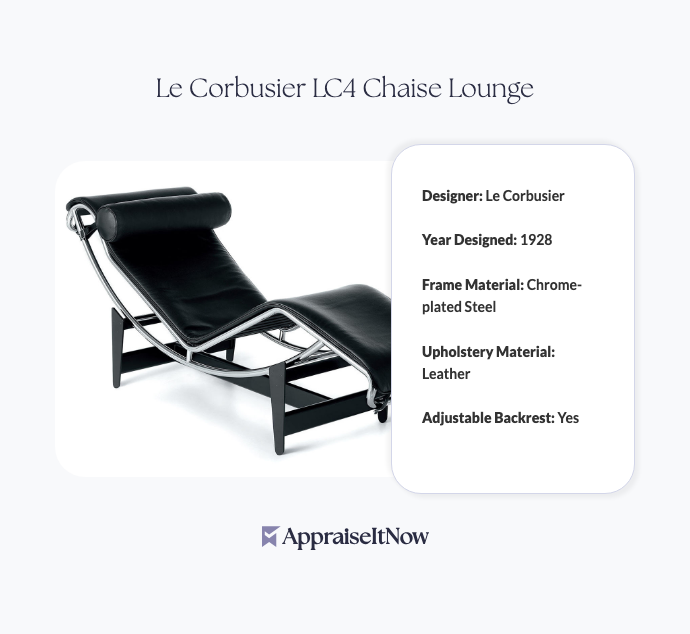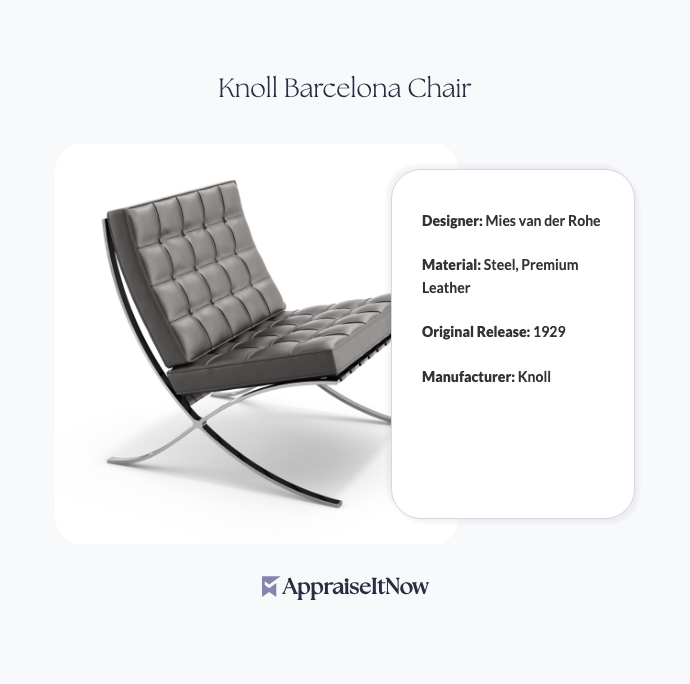<h1>How to Get Your Wassily Chair Appraised</h1>
<p>The Wassily Chair—also known as the Model B3 Chair—stands as one of the most iconic pieces of modernist furniture ever designed. Created by Marcel Breuer in 1925-1926 for the Bauhaus school, this revolutionary piece combines functional design with sculptural elegance, making it highly sought after by design enthusiasts, collectors, and institutions worldwide. If you own or are considering acquiring a Wassily Chair, understanding its market value and how to get it properly appraised is essential for insurance, sale, or collection management purposes.</p>
<h2>Understanding Wassily Chair Value</h2>
<p>The Wassily Chair typically commands prices between <strong>$1,000 and $5,000</strong> in today's market, though authenticated originals and rare variants can exceed these ranges significantly. The chair's value reflects its position as a foundational modernist design piece and its enduring influence on contemporary furniture aesthetics. Whether you're evaluating an inheritance, planning an estate sale, or documenting your <a href="/types/furniture">furniture</a> collection, a professional appraisal provides the credibility and documentation necessary for any transaction or insurance claim.</p>
<p>Several factors determine where your specific chair falls within this valuation range. The distinction between authentic Knoll-manufactured pieces and reproductions represents perhaps the most significant value differentiator, with genuine examples commanding substantially higher prices. Understanding the markers of authenticity—and knowing where the Knoll stamp appears on a Wassily Chair—becomes crucial when determining what makes your piece worthy of professional evaluation.</p>
<h2>Identifying Your Wassily Chair's Authentication</h2>
<p>Before seeking an appraisal, you'll want to identify whether your chair is an authentic Knoll production or a later reproduction. This distinction fundamentally affects value and appraisal methodology. Original Wassily Chairs manufactured by Knoll International feature specific design elements and manufacturing markers that distinguish them from countless reproductions released after Breuer's original patent protection expired.</p>
<p>The Knoll stamp on a Wassily Chair typically appears on a small metal plate attached to the frame, usually located near the bottom of the chair where the tubular steel support connects. Original Knoll pieces display this marking prominently, along with model numbers and production dates. However, the chair's authentication extends beyond simple stamp verification—genuine originals exhibit specific welding techniques, leather quality, and tubular steel specifications that require expert assessment.</p>
<div class="callout tip"><p><strong>Authentication Insight</strong></p>
<p>How can you tell if your Wassily Chair is real? Authentic pieces display consistent welding patterns, original leather with appropriate patina, and precise frame dimensions matching Breuer's original specifications. Professional appraisers use comparative analysis and hands-on inspection to verify authenticity.</p></div>
<p>The leather upholstery itself provides important authentication clues. Original Knoll examples utilize supple, high-quality leather that ages distinctively over decades, developing characteristic wear patterns that reproductions struggle to replicate convincingly. The way leather wraps around the frame, the stitching patterns, and the brass hardware all contribute to authentication assessments during the appraisal process.</p>
<h2>Key Specifications That Affect Appraisal Value</h2>
<p>When appraising your Wassily Chair, specialists examine multiple technical and aesthetic dimensions. The chair's distinctive cantilever frame made of tubular steel remains its defining characteristic—a revolutionary engineering concept in 1925 that influenced furniture design globally. Understanding these specifications helps you appreciate why professional evaluation matters.</p>
<p>The tubular steel construction in your chair should exhibit consistent diameter tubing, precise bends, and appropriate welding that reflects its manufacturing period. Early production Knoll examples often display hand-welded seams, while later versions show more uniform factory processes. The frame's integrity directly impacts safety and value—stress cracks or corrosion require professional remediation that affects appraisal outcomes.</p>
<p>Your chair's leather upholstery comprises another critical specification. Original Knoll pieces typically featured premium leather sourced from specific European suppliers, distinguishing them from later reproductions that often utilized different leather grades. The leather's thickness, color consistency, and aging characteristics all factor into authentication and valuation during professional appraisal assessment.</p>
<h2>Why Professional Appraisals Matter for Your Collection</h2>
<p>Getting a proper appraisal of your Wassily Chair serves multiple purposes beyond simple curiosity about its monetary worth. Insurance companies require documented valuations for coverage, ensuring your design investment receives adequate protection. Estate planners need accurate values for proper asset distribution and tax purposes. Collectors seeking to buy or sell through auction houses or private dealers benefit from professional certification that establishes market positioning and prevents costly transaction disputes.</p>
<p>Professional appraisers specializing in <a href="/blog/appraising-contemporary-design-and-furniture-evaluating-modern-artistry">modernist and contemporary design</a> understand the nuanced factors driving Wassily Chair valuations. They verify authenticity through comparative analysis of known examples, examine condition comprehensively, and research provenance documentation that adds significant value to authenticated pieces. This expertise distinguishes professional appraisals from casual online valuations or dealer estimates.</p>
<div class="callout note"><p><strong>Professional Advantage</strong></p>
<p>A USPAP-compliant appraisal from a certified expert provides documentation accepted by insurance companies, courts, auction houses, and financial institutions—essential when your Wassily Chair represents a meaningful asset.</p></div>
<h2>Condition Assessment and Its Impact on Value</h2>
<p>The physical condition of your Wassily Chair directly determines its position within the market value range. An excellent condition example displaying minimal wear and original materials commands premium pricing, while pieces requiring restoration or displaying significant leather deterioration fall toward the lower valuation spectrum. Professional appraisers grade condition systematically, examining frame integrity, leather condition, stitching quality, and overall functionality.</p>
<p>Frame condition represents the most critical assessment element. Your tubular steel should show no structural damage, stress cracks, or significant corrosion. Even minor welding repairs or frame straightening can reduce value if not documented appropriately. The leather's condition ranges dramatically—original patina valued by sophisticated collectors differs substantially from worn leather requiring re-upholstering, which significantly diminishes value.</p>
<p>Original hardware including brass fasteners, frame connections, and adjustment mechanisms all factor into condition assessment. Replacement hardware, while sometimes necessary for functionality, typically reduces market value compared to original components. Appraisers document these variations, providing clarity on how condition impacts your specific chair's valuation.</p>
<h2>Documentation and Provenance Considerations</h2>
<p>Your Wassily Chair's provenance—its ownership history and documented lineage—substantially influences appraisal value. Chairs with clear attribution to notable designers, architects, or institutions command premiums over undocumented examples. Original purchase receipts, correspondence with sellers, exhibition catalogs, or gallery documentation all enhance value and facilitate authentication during the appraisal process.</p>
<p>Professional appraisers like those at <strong>AppraiseItNow</strong> understand how to research and verify provenance through auction house records, design archives, and expert networks. This detective work often reveals valuable information about your chair's origins that impacts its market positioning. Even modest documentation improvements—such as comparative photographs showing identical examples in museums or published design surveys—strengthen your appraisal's credibility.</p>
<div class="callout tip"><p><strong>Documentation Value</strong></p>
<p>Photographs comparing your Wassily Chair to authenticated museum examples, gallery catalogs featuring identical models, or purchase documentation can increase your piece's appraised value by 15-25% compared to undocumented examples.</p></div>
<h2>Comparing Your Wassily Chair to Similar Designs</h2>
<p>While the Wassily Chair dominates modernist furniture consciousness, understanding how it positions against contemporary design pieces helps contextualize its value. The Cesca Chair, also designed by Breuer and manufactured by Knoll, typically commands lower prices ($600-$1,500 range) despite similar design principles, partly because it was produced in larger quantities and remains in continuous production. Your Wassily's relative scarcity—particularly for early production examples—contributes to its stronger market positioning within <a href="/types/antique-furniture">antique furniture</a> collecting circles.</p>
<p>Other modernist classics like the Barcelona Chair (Mies van der Rohe) or the Eames Lounge Chair achieve comparable or higher valuations depending on production era and condition, creating a competitive high-end design market. Understanding these comparative values helps appraisers position your Wassily Chair appropriately and identify which market segment—whether serious collectors, design professionals, or institutions—represents your most valuable buyer pool.</p>
<h2>Choosing the Right Appraiser for Your Wassily Chair</h2>
<p>Selecting an appraiser specializing in modernist furniture and design collectibles ensures your chair receives expert evaluation from someone understanding its historical significance and market dynamics. Look for appraisers with credentials from recognized organizations like the American Society of Appraisers (ASA) or International Society of Appraisers (ISA), particularly those with documented experience in <a href="/types/furniture">furniture appraisals</a> and contemporary design evaluation.</p>
<p>Your appraiser should provide a detailed written report documenting condition, authentication findings, comparative market analysis, and photographic evidence. This comprehensive documentation proves invaluable whether you're seeking insurance coverage, planning an estate sale, or simply documenting your collection for personal records. Professional services like <strong>AppraiseItNow</strong> connect you with USPAP-compliant appraisers across the U.S., ensuring credentialed experts evaluate your specific piece.</p>
<p>When interviewing potential appraisers, ask about their experience with Wassily Chairs specifically, their authentication methodology, and their familiarity with both original Knoll production and later reproductions. Their ability to discuss technical specifications, manufacturing variations across production eras, and market trends indicates expertise that translates into reliable valuations. Understanding <a href="/blog/decoding-the-value-of-antique-furniture-materials-craftsmanship-and-historical-context">how to accurately determine furniture values</a> requires specialists who grasp both the design history and current market conditions.</p>
<h2>Current Market Trends Affecting Wassily Chair Values</h2>
<p>Modernist design collecting has experienced sustained growth over the past two decades, with prices for authenticated Wassily Chairs appreciating steadily. Millennial and Gen X collectors increasingly seek quality vintage design pieces, expanding demand and supporting valuations. The Wassily Chair's status as perhaps the most recognizable modernist furniture design—appearing in design history texts, museums, and popular culture—maintains collector interest across demographics.</p>
<p>Contemporary interior design trends emphasizing minimalism and functional aesthetics have renewed appreciation for Breuer's design philosophy, indirectly supporting Wassily Chair market values. Institutional collecting by museums and design schools continues acquiring examples for permanent collections, providing baseline value support. These market dynamics suggest your Wassily Chair represents a relatively stable investment asset compared to trend-dependent design pieces.</p>
<div class="callout note"><p><strong>Market Insight</strong></p>
<p>The Wassily Chair's consistent appearance in major museum collections and its continuing influence on contemporary designers supports valuation stability, making it an attractive addition to serious design collections.</p></div>
<h2>Insurance and Documentation Requirements</h2>
<p>Once you obtain a professional appraisal, use that documentation for comprehensive insurance coverage. Standard homeowners policies typically exclude or undercover collectible furniture, requiring separate riders or specialized coverage for pieces valued above $5,000. Your appraiser's detailed report becomes essential documentation for insurance purposes, establishing replacement cost and supporting claims if damage or loss occurs.</p>
<p>Maintain your appraisal documentation alongside photographs of your Wassily Chair from multiple angles, close-ups of the Knoll stamp and authentication markers, and any provenance materials. This organized documentation file facilitates insurance claims, estate distribution, or sale transactions. Professional appraisers typically provide high-resolution photographs as part of their service, creating a comprehensive visual record of your piece's condition.</p>
<p>Consider updating your appraisal every 3-5 years, particularly if market conditions shift substantially or if you make conservation treatments. This periodic re-evaluation ensures your insurance coverage remains current with market values and provides updated documentation for any future transactions.</p>
<h2>The Value of Professional Authentication</h2>
<p>Beyond monetary valuation, professional appraisal provides authentication that protects your interests in any transaction. Whether buying, selling, or insuring your Wassily Chair, third-party certification from a credentialed expert prevents costly disputes and ensures all parties share confidence in the piece's authenticity and condition. This authentication proves invaluable when navigating the competitive modernist furniture marketplace where reproductions proliferate.</p>
<div class="callout note"><p><strong>Key Takeaway</strong></p>
<p>A professional appraisal of your Wassily Chair delivers authenticated valuation documentation, accurate market positioning within the $1,000-$5,000 range, and credible certification suitable for insurance, estate planning, or sale purposes. Whether your chair represents a cherished design investment or a recently discovered collection piece, expert evaluation ensures you understand its true worth and can make informed decisions about acquisition, insurance, or disposition.</p></div>







.avif)







